June 16 – July 1, 2016: Belturbet, Ireland
After the wonders of the Galapagos and the weirdly liminal stopover in Boston, I am expecting Ireland to feel familiar. After all, I flew into this airport, on this airline, just two years ago – there’s an odd sense of coming full circle.
Instead, Ireland hits my body with a shock. It is grey and raining; we see little of the countryside until we’re practically over the tarmac. My hard-won tan is completely covered by jeans and a sweatshirt. The line to get through immigration is ridiculously long – three overnight flights from the US have all landed within the same hour, and there are only 4 agents clearing non-EU passengers.
Memories of landing on a bright, beautiful sunny spring day two years ago keep interfering with what’s before me in the present. I remember how excited I was to finally be starting my nomadic adventure, and how beautiful and green and Irish everything looked. I remember the bus ride into town and walking along the River Liffey before heading out to the ferry dock.
Today I walk out into the rain in search of my express bus. The line at immigration is so long that my 2 hour layover is reduced to just enough for one final bathroom break and to find my bus stop.
The bus is much more crowded than I expect it to be. I sit near the back, next to a pleasant woman who’s on the phone with her friend. We chat briefly as the bus pulls away from the airport. She has recently moved to Donegal and used to work for the European Space Agency. She also does a fairly good Texas drawl (she’s married to a Texan).
I’m glad we chat a bit at the beginning of the trip, because without her I would never have known I’d arrived in Belturbet. These express buses don’t announce the towns they arrive in; I guess you’re just supposed to know when to get off.
My Airbnb host meets me at the bus stop and drives me the 2 minutes to the townhouses across the river. He then takes me to lunch and gives me a brief tour of the village. It’s a very small village – 2,000 or 3,000 people at most. There are a surprising number of pubs and takeaway restaurants for such a small place, and the cluster of buildings at the end of high street is quite charming.
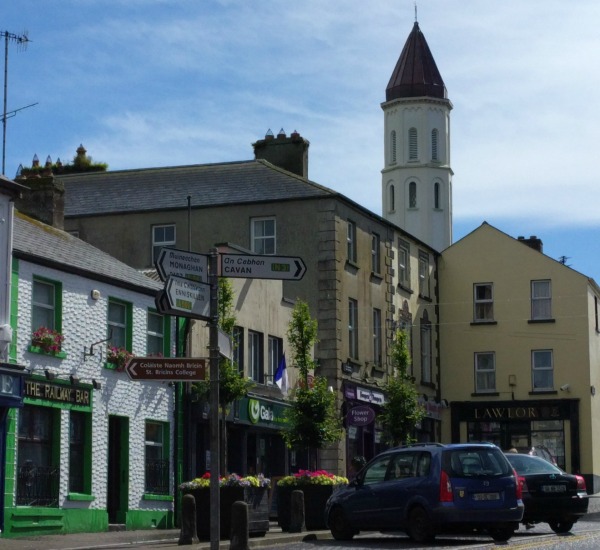
As a host, Tony is kind, friendly, and talkative. However, I learn that the townhouse I’ve rented isn’t ready yet, so I’ll be staying in a guest room in his townhouse for a few days. His townhouse is cluttered and my room, although spacious, has a feeling of shabbiness to it.
There’s also no internet at the house, which is a problem since I have to work for the first two days I’m here. He sets me up in the office that’s on the ground floor of the townhouse I have rented.
When I move into my townhouse a few days later, it’s like moving into a bachelor pad. Every dish in the open-air kitchen cupboards has to be scrubbed free of dust before it can be used. There’s no wash basin for the sink, and to get the stove to work you have to plug it in first, then use only the left burner because the right one doesn’t turn on.
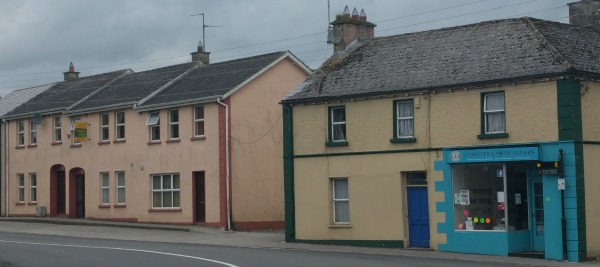
My host lives in the blue door. My townhouse is the first door in the peach building.
On the plus side, all the rooms are clean, the internet works wonderfully here, and the space is my space. There’s a small desk on the landing I can use for a workspace, and the grocery store is a mere 15 minute walk away. The River Erne is also just across the road, which is loveliness itself.
Tony also tells me that the townhouse is unavailable for two weeks in August, which is precisely when my boyfriend is coming to visit. He offers to put us up in the same guest room I’ve just moved out of, but the lack of internet and lack of our own space is not what we had in mind for our vacation.
Instead, I book several days in Cork for mid-August before planning to meet my boyfriend’s plane in Dublin. We’ll spend a few days in Dublin seeing the sights (the Book of Kells, the bog bodies at the national museum, the castle), then head out to Sligo for a week.
I am irritated by the complete lack of communication about housing arrangements ahead of time – neither my boyfriend nor I had budgeted for hotel expenses during his trip. On the bright side, I’ll get to see more of Ireland than I could by simply taking day trips!
I don’t do much exploring the first few days I’m here, because I come down with a head cold on Saturday morning that keeps me indoors most of the weekend. I can’t tell if it’s the cold or something else, but my sleep schedule is also screwed up. I’m staying up until 3 or 4 am and getting up at noon. It takes more than a week to finally get back on a “bed at midnight, up at 8 am” schedule.
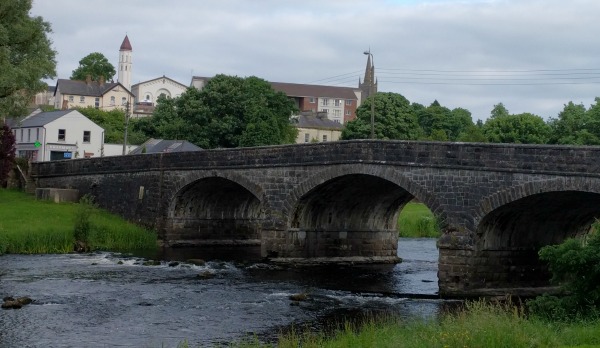
Kilconny Bridge with Belturbet skyline
After the first week and a half, things get better. My head cold lingers as an occasional cough for another week, but I’m able to explore the town and the surrounding countryside. Since we’re so close to the summer solstice, it gets light at 5 am and stays light until just after 11 pm. It’s overcast most of the time, sometimes raining, sometimes not. The best time to catch the sun is early in the morning or in the hours before sunset.
Belturbet is an Anglicization of the Gaelic Béal Tairbirt. Tairbirt or Turbet is the island from which the town takes its name. A settlement sprang up here because this was the only fording spot for the River Erne for miles around. A motte and bailey castle was built on Turbet Island in 1210 or 1211 by John Le Grey, King John’s Justiciar in England. (And yes, that would be the same King John from the Robin Hood legend).
King John had some grandiose ideas about conquering the Irish chieftains (he built one of the first castles in Dublin), but like most things King John did, the plans didn’t amount to much. The motte and bailey here in Belturbet seems to have been abandoned a few years after construction, and all that remains today are the hills upon which the motte and baily stood.
By far my favorite place in Belturbet is Turbet Island. It’s not a large island – you can walk the entire circuit in about 20 minutes. The path starts at Kilconny Bridge and follows the western side of the island, then crosses a footbridge to the western bank, crosses the river via the old railroad bridge, and goes up the east bank back towards Kilconny Bridge.
The views of the River Erne from this walking path are stunning. The color of the water changes based on the weather, so every day is different.
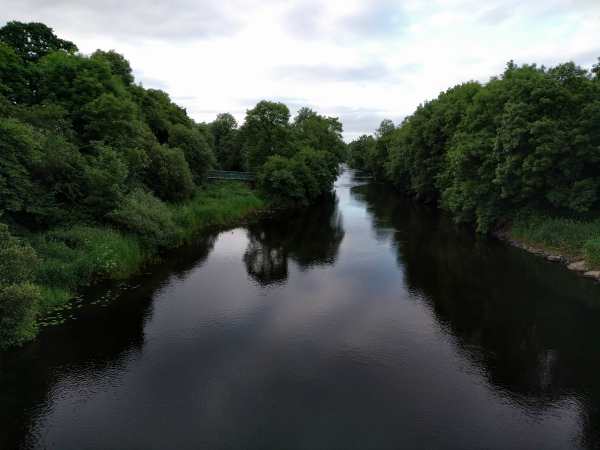
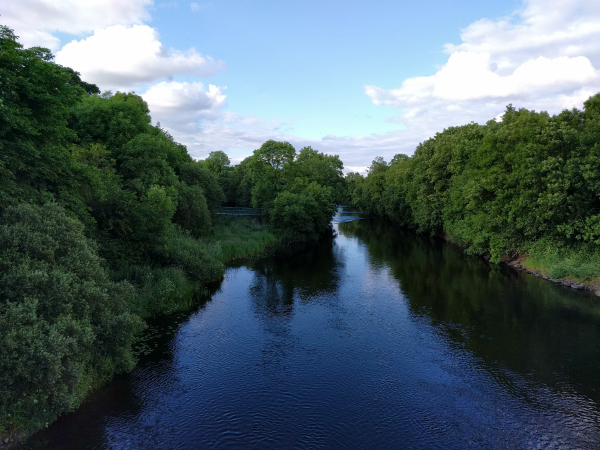
My favorite place to take pictures is the old railway bridge, which forms the southernmost loop of the walking path.
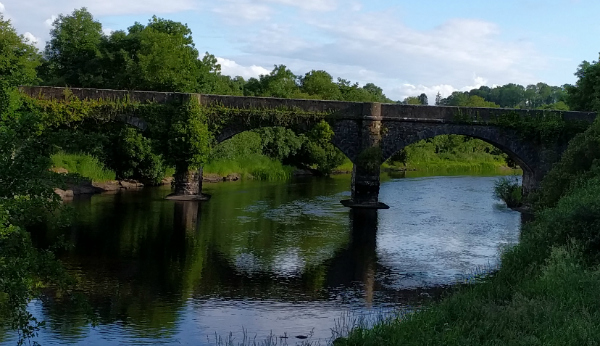
One day I meet Frieda, a Belturbet native in her 70s who walks this path three times a day. She tells me about the two railroad companies that used to meet in Belturbet: the Great Northern Railroad, and the Narrow Gauge Railroad. She was on the last train that ever ran on the Narrow Gauge Railroad. In fact, the train was so slow that she and her friends could run along beside it! Today all that’s left is a bit of walking path, the bridge, and the old rail station.
At the eastern edge of the bridge, there’s a small cross with a rosebush. A local Belturbet man died of a heart attack on Christmas Day at that spot some years ago. His niece erected the marker and planted the roses.
To the south of the railroad bridge, you can just see the suspension bridge for the motorway that passes outside town.
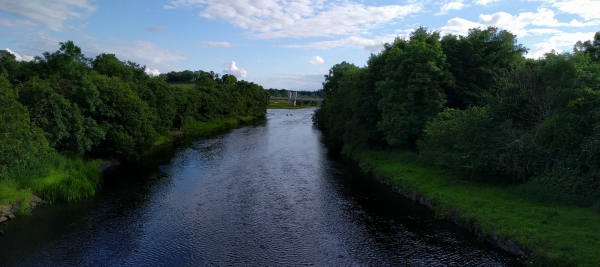
When she was a girl, Frieda and her family would go along the river bank between the two rivers with friends or family and play in and along the river. They would know when it was time to go home when the narrow gauge train steamed by on the railway bridge!
Frieda also tells me that the main river channel used to be the side channel. At some point in the past, the old main channel became too rocky to keep dredged, and so the river was diverted into a new main channel that would be easier to maintain.
Today the side channel is mostly dry, with pools of water collecting along the bottom:
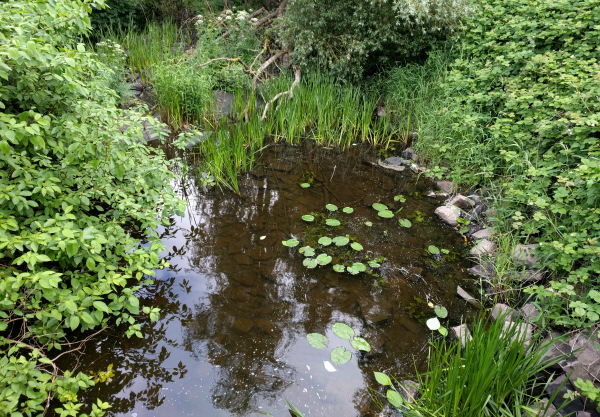
Frieda explains that summer is the dry season in Ireland. In the winter, the river will rise several feet and cover quite a bit of the low-lying edges of the island.
After a week of seemingly unending grey, the sun comes out. It is warm and glorious and freeing. I take many pictures on my daily island walk.
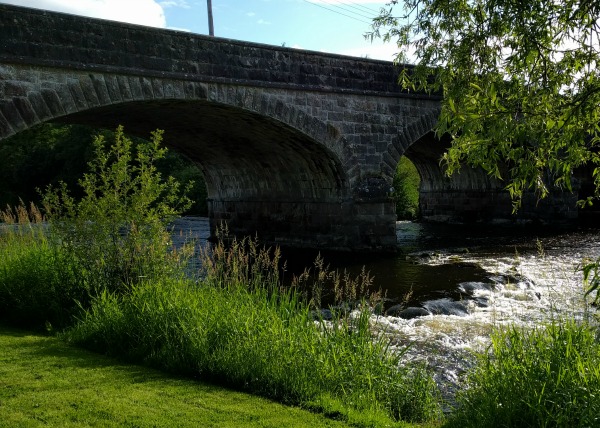
Kilconny Bridge
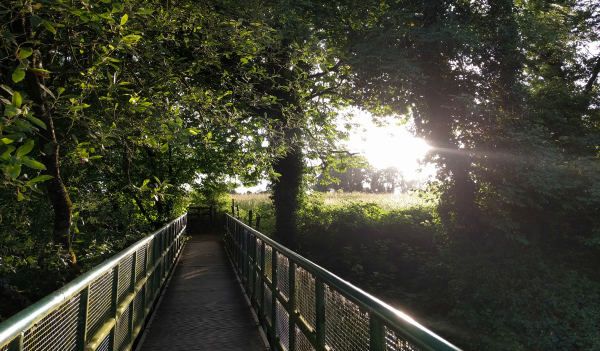
Footbridge from Turbet Island to west bank
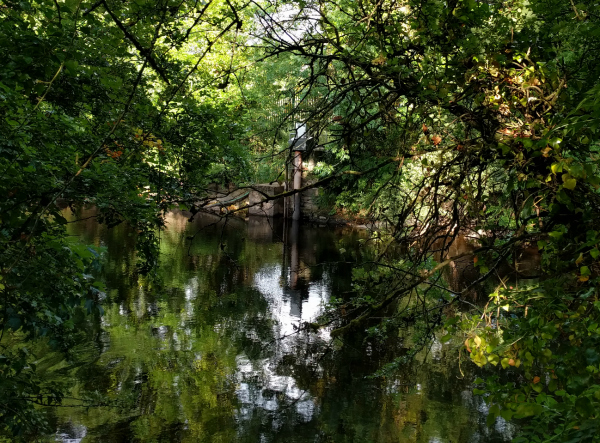
River Erne, with town water pump on opposite bank
One day I follow the railroad path up the hills instead of taking the footpath down the eastern shore of the river. I pass a field full of Irish cows
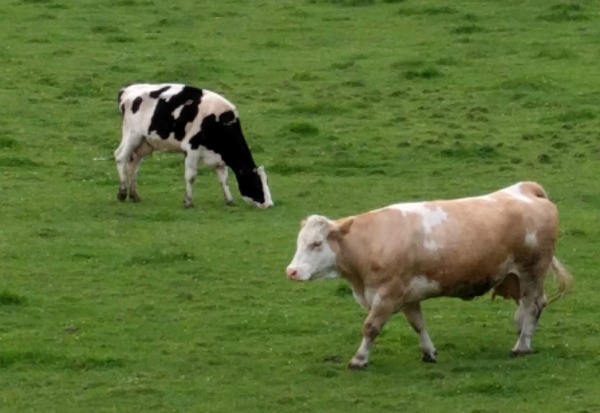
before coming out on the hill that forms the eastern part of the town of Belturbet. I call it Church Hill, since both the Roman Catholic and Church of Ireland churches are located here.
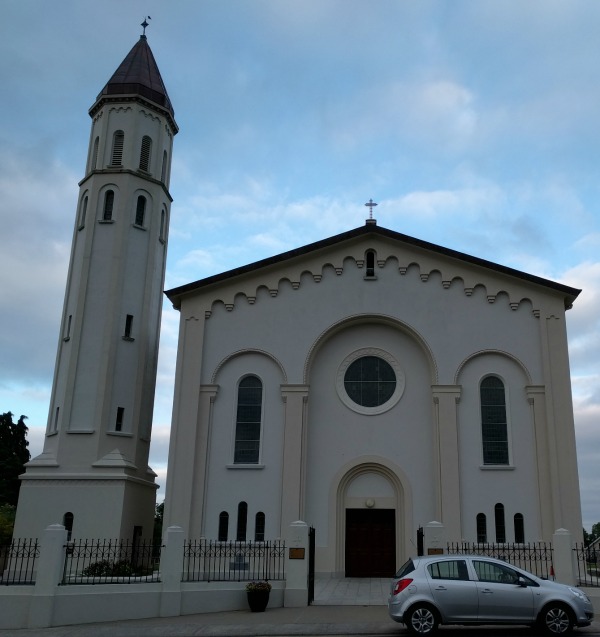
As I cross Kilconny Bridge to head home, the view downstream towards the marina, is too gorgeous to resist.
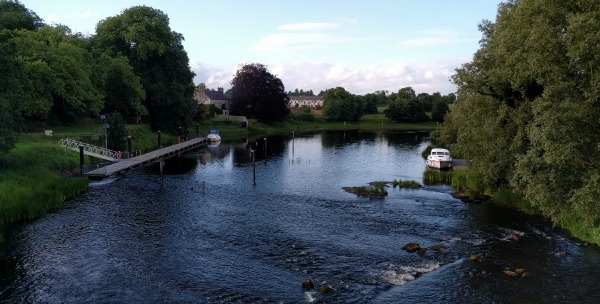
All in all, a rockier start to my summer in Ireland than I expected. But now that I’m settled in my own space and feeling better, I’m excited to start exploring places other than Belturbet.
Up next: a stroll through the Irish countryside. 🙂

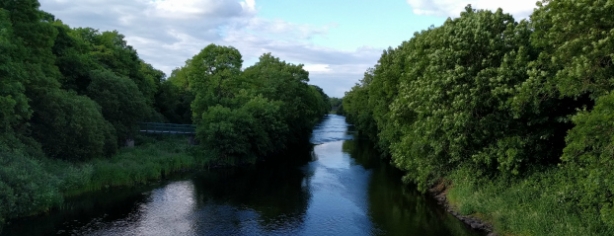









The Irish environment is a major contrast from both Boston & the Galapagos. It was easy enough to find your location via Google’s street view, though it appears that your host has done some painting since Google passed by.
It reminds me a little of the more rural areas in Wisconsin — quite a few lakes and a bit of swamp land near by, though there appears to be a few hills (Erne Hill).
Most businesses appear to be on the other side of the river — other townhouses look similar to where you’re living. I was unable to “get a read” on the bridges actual age — I assume relatively recent, even though the facade has a Roman influence.
Irish cows — well, the Holstein is a “probably not”, but the Irish Moiled (brown & white) definitely is.
Given the “lackings” (stove, forced move during boyfriend’s visit, gloomy weather), what’s your general feeling? The environment doesn’t strike me as “typical Irish”, if there is such a thing. At least you’ve met one friendly person…
Historically — the “times of troubles” along with car bombings did hit that area. It is near the border and was part of the Ulster Plantation, which has some significance (Irish rebellion, Cromwell, etc). Too bad the “mott & bailey” on Turbet Island and O’Reilly’s castle didn’t survive…
It does feel quite a bit like rural Wisconsin – tractors coming through town, lots of haybailers and cows around. Lakes and hills and all the rest, too, as well as friendly local people.
My general feeling for the first few weeks was not great. It’s improving, though – the sun’s come out more often, and I’ve been getting away on the weekends. I found a pub in town last week that I really liked, too – they have live music on Sundays. It probably won’t be the most memorable of my travels, but it is moving up the enjoyable notch. (Still not a fan of the forced move or the lack of stove in own house, though).
As for the bridges, the Kilconny bridge plaque says 1860s. I would guess the railroad bridge is similar; railroads were a big thing here in the UK when the Industrial Revolution arrived. The motte & bailey was built in the 1200s and abandoned a few years later; I don’t think it had anything to do with the Troubles that plagued the northern border recently.